https://ift.tt/3dvnWs4
Starting the ketogenic diet can be overwhelming. The keto beginner is often bombarded by conflicting information regarding the “right” way to follow the diet and enter ketosis.
Though experts may not agree on the exact details of a “perfect” keto diet, there are several low-carb food groups that are widely accepted as healthy keto staples. To give you a visual representation of what these foods are, we decided to create a keto-friendly food pyramid for you.
This keto food pyramid will look similar to the original USDA food pyramid, but with one crucial difference: We feature food groups that help promote health and ketosis.
Along with the keto-friendly food lists and resources that follow, the keto food pyramid will provide you with the info you need to get started right away (in a way that is also right for you). Let’s begin by exploring the two foundational principles of keto eating.
Keto Food Pyramid Principle 1: Macro Ratios for Ketosis
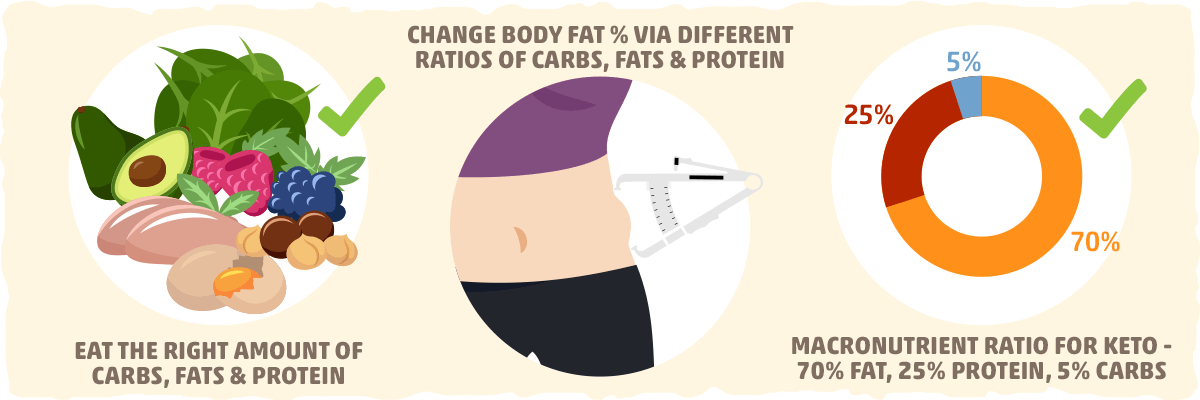
The first rule of keto is to eat the right amount of carbs, fat, and protein. These are the three primary nutrients we get from food (also known as “macronutrients” or “macros”).
By eating different ratios of carbs, fat, and protein each day, we can manipulate what our body uses as fuel and gradually change our body fat %.
On the ketogenic diet, we must limit carbs low enough to shift our primary fuel source from carbs to fat and promote ketosis (i.e., when our body consistently produces ketones for fuel). In contrast, by eating too many carbs, we prevent our body from being in this fat-burning, ketogenic state.
In practical terms, the macronutrient ratios needed for ketosis will be around 70% fats, 25% protein, and 5% carbohydrate.
That said, being in ketosis and burning fat for fuel isn’t all that matters on keto — It’s simply the first step.
Keto Food Pyramid Principle 2: Whole Foods for Optimal Health and Weight Loss
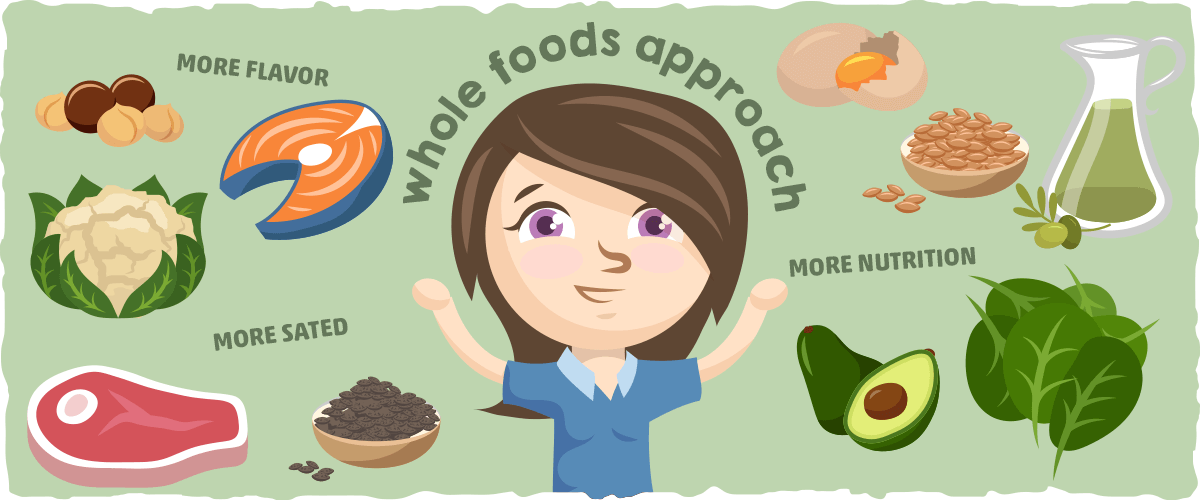
If we solely focused on macros, the keto food pyramid would feature pure fats and oils as the base. (Unfortunately, this is how most keto food pyramids look, and it is quite confusing).
For example, an “ideal” day from a keto macro perspective would feature a stick of butter garnished with ground meat and a small side dish of plain spinach dressed with olive oil.
Though meals like this will promote ketosis, they also increase the likelihood that we over-consume fat, gain weight, and become deficient in essential nutrients.
This is why we advocate for a whole foods keto approach, where minimally-processed low-carb foods serve as the basis of your fat, protein, and carb consumption. Not only will this approach provide you with the right keto macro ratios, but you’ll get more flavor, nutrition, and satiety from each bite.
To see what this looks like, check out the keto food pyramid below.
Keto Food Pyramid: Promoting Optimal Health, Weight Loss, and Ketosis with Whole Foods
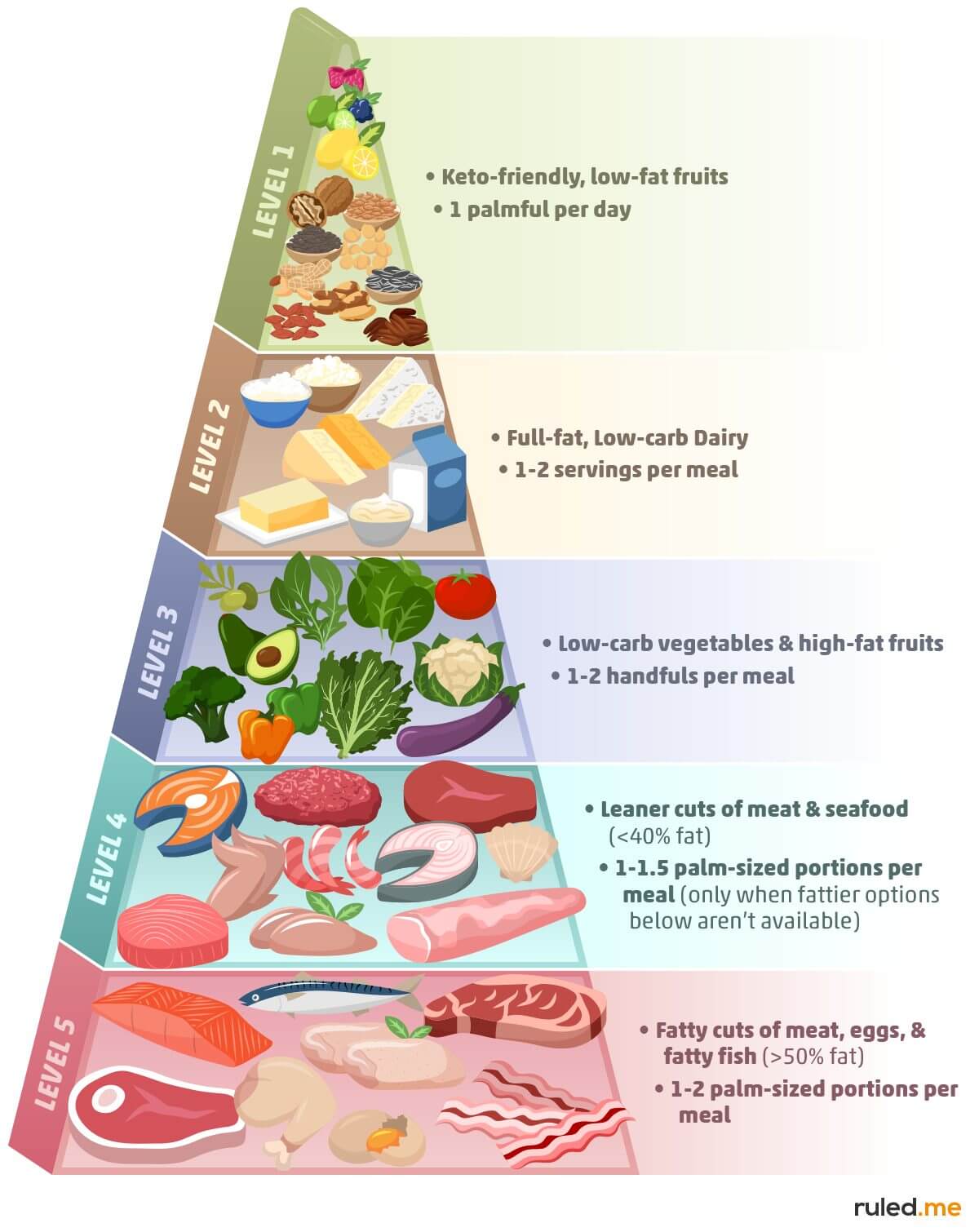 Upgrade fat content of meals with 1-2 tbsp of high-quality fats/oils:
Upgrade fat content of meals with 1-2 tbsp of high-quality fats/oils:
- Butter
- Extra virgin olive oil
- Bacon grease
- Coconut oil
- MCT oil
Upgrade flavor with:
- Herbs & spices
- Salt & pepper
- Keto-friendly condiments — sugar-free bbq sauce, keto ketchup, marinara, hot sauce, mustard, etc.
Upgrade food quality for optimal health:
- Pasture-raised meat, eggs, and dairy
- Sustainably-sourced fish and seafood
- Local, organic, and biodynamic vegetables, fruit, nuts, and seeds
Keto drink staples:
- Plain water
- Carbonated water
- Black coffee
- Unsweetened tea
- Bone broth
- Flavored zero-calorie beverages made with natural keto sweeteners
The other side should feature foods and drinks to avoid on keto:
Avoid:
- Grains – wheat, corn, rice, cereal, bread, baked goods, etc.
- Legumes — beans, lentils, chickpeas, etc.
- Sugar – honey, agave, maple syrup, etc.
- High-sugar fruits – apples, bananas, oranges, etc.
- Starchy vegetables – potato, yams, yucca, etc.
- High-carb drinks — regular soda, fruit juice, most regular beers, etc.
As a shortcut, here’s a graphic that includes all of the information above:
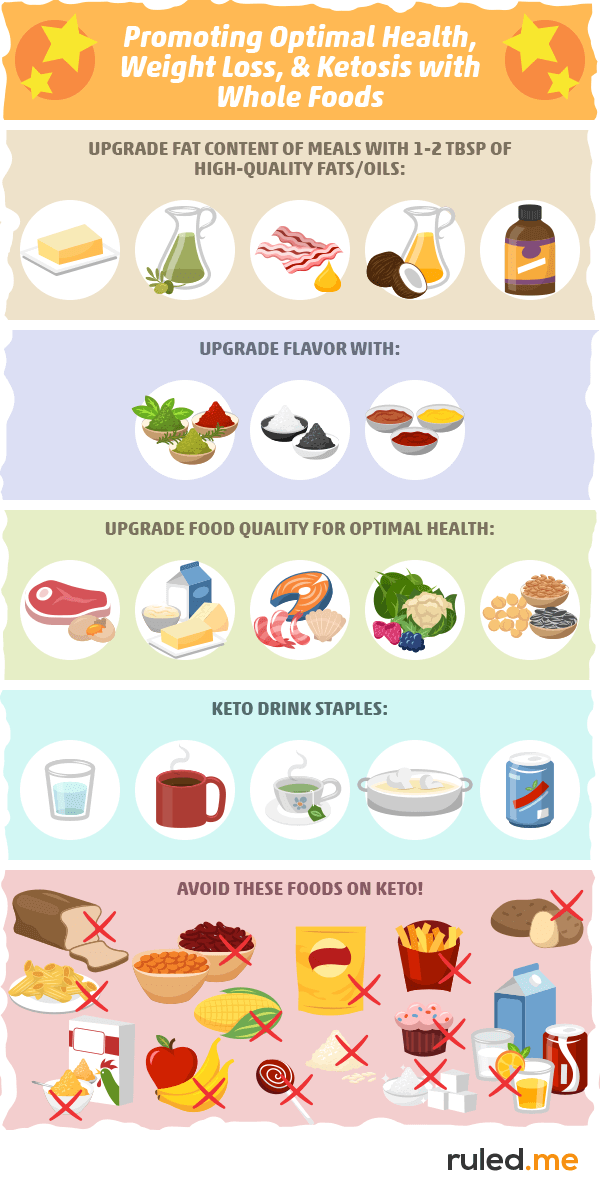
How to Use the Keto Food Pyramid
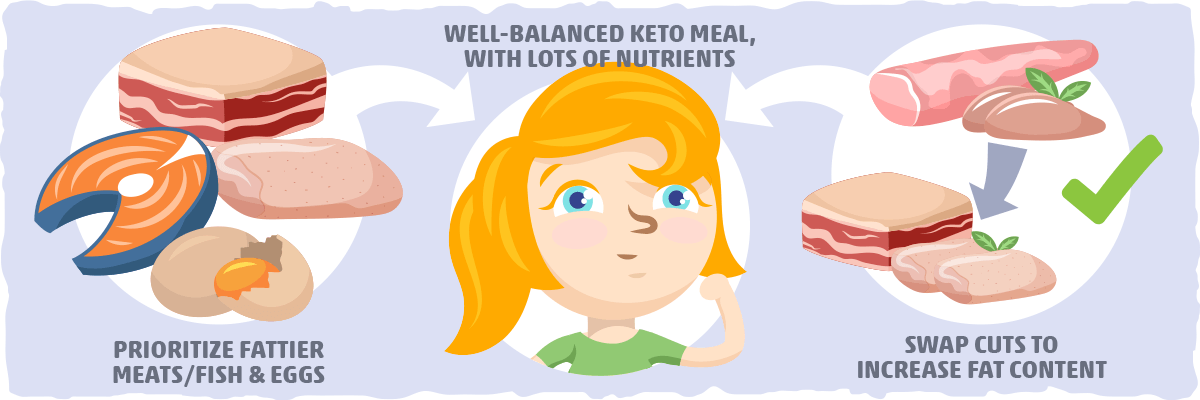
When you’re looking to plan your keto meals, start from the bottom and prioritize those fattier cuts of meat/fish and eggs. As an example, you want to opt for the budget-friendly skin-on, bone-in chicken thighs rather than the over-priced chicken breast, the pork shoulder instead of the pork tenderloin, and so on.
Not only will these simple swaps significantly increase the fat content of your meal, but you’ll also get a well-rounded source of fatty acids, minerals, and proteins (including collagen).
Next, you’ll add another high-fat, low-carb food (like avocado, olives, and cheese) to boost the fat to around 70% (if necessary) and incorporate a low-carb veggie to up your fiber, vitamin, mineral, and antioxidant intake.
This whole foods keto approach will help you create a well-balanced keto-friendly meal with plenty of health-promoting nutrients. Additionally, these foods can also help you breeze through the keto flu and any other symptoms that may occur as your body adapts to carb restriction and ketosis.
Now, with our keto foundation set, let’s take a closer look at each level of the food pyramid: Starting at the base.
The Base of The Keto Food Pyramid: Fatty Cuts of Meat, Fatty Fish, and Eggs
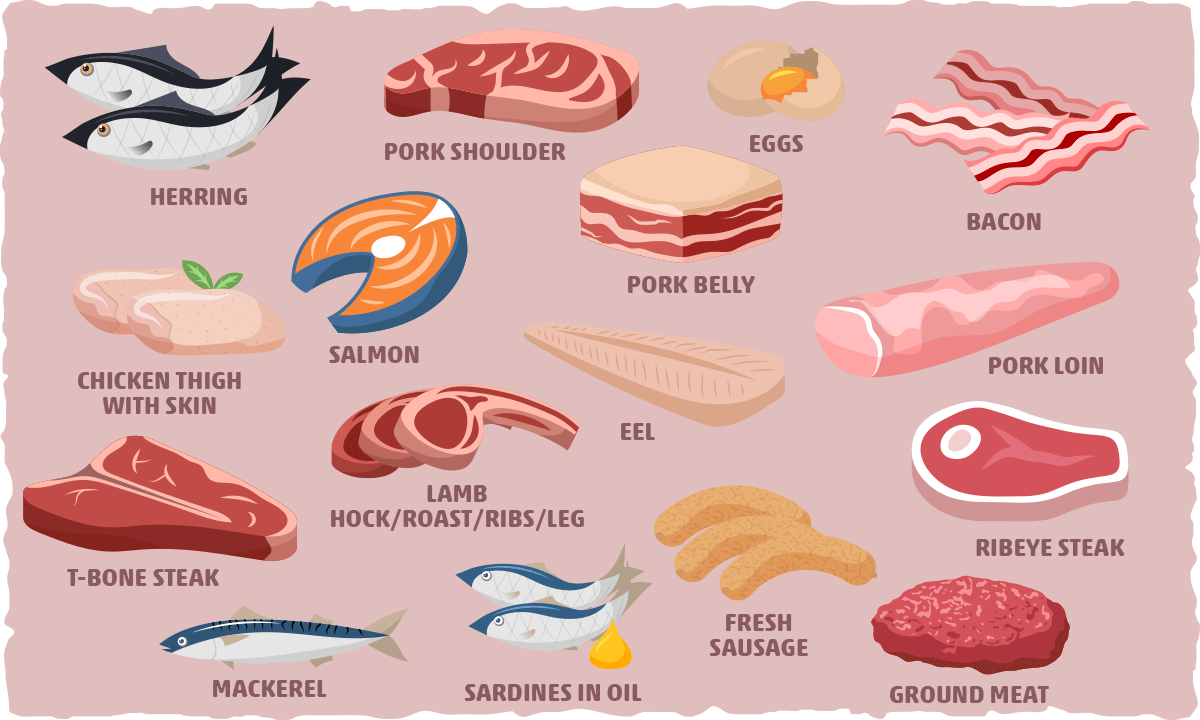
This category of low-carb foods is often the feature ingredient of keto entrees.
As a general rule of thumb, each meal should have roughly 1-2 palm-sized portions (i.e., between 3 and 6 ounces) of foods from this category.
To fit into this group, the food should contain at least 50% fat and less than 5% carbs. For a better idea of what foods to look for, we’ve included an extended list of keto-friendly choices below.
List of the Fattiest Fish and Seafood for Keto
- King (chinook) salmon
- Sardines, packed in oil
- Mackerel
- Herring
- Eel
List of the Fattiest Cuts of Meat
- Chicken thigh, skin on
- Duck leg, skin on
- Bacon
- Pork belly
- Pork shoulder (Boston butt)
- Pork loin (not tenderloin)
- Pork chop
- T-bone steak
- Rib-eye steak (also known as rib roast or prime rib)
- Oxtail
- Ground lamb
- Lamb hock
- Lamb roast
- Lamb ribs
- Lamb leg
- Fresh sausage — Sausages will vary in fat content and added sugar, so make sure you get the highest fat option with no additional carbs.
- Head cheese, Liverwurst, and Braunschweiger — Double-check ingredients for high-quality meats and no added sugars
And of course, don’t forget this keto staple:
- Whole eggs
Other high-fat options that almost make the cut (Between 40 and 50% fat)**:
- Beef brisket
- Flap steak
- Filet mignon (Chateaubriand or tenderloin)
- Porterhouse steak
- Skirt steak
- New York strip steak
- 55% lean ground beef or pork
** Add a high-fat cheese, high-fat fruit, or melt a tablespoon of butter on top to increase the fat content above 50%.
The Second Level: Leaner Cuts of Meat and Seafood
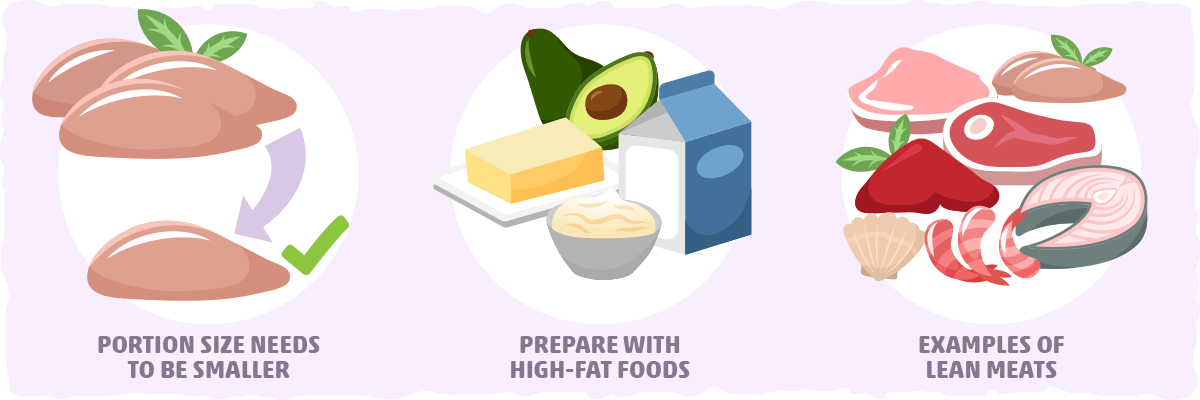
When fattier cuts aren’t available, leaner options can still be good for keto as long as you keep these two things in mind:
- The portion size may need to be a bit smaller, especially if you have very lean meats (e.g., skinless chicken breast or turkey breast).
- Make sure you prepare it with high-fat cheese, avocado, and/or other high-fat, low-carb foods from the pyramid and supplement the meals with high-quality fats/oils if necessary.
To give you an idea of what fits into the leaner cuts of meat/seafood category, we’ve included a list below. In general, these cuts have less than 40% calories from fat:
- Pork tenderloin
- Pink salmon
- Sockeye salmon
- Cod
- Tuna
- Trout
- Turkey
- Chicken breast
- Chicken wing
- Duck breast
- Seabass
- Shellfish
- Sirloin tip side steak
- Top round steak
- Eye of round steak
- Bottom round steak
- Top Sirloin
- Beef liver
- Beef heart
- Ground beef (70% lean / 30% fat)
- Ground pork (~70% lean)
Keto Food Pyramid Level 3: Low Carb Veggies and High-fat Fruit
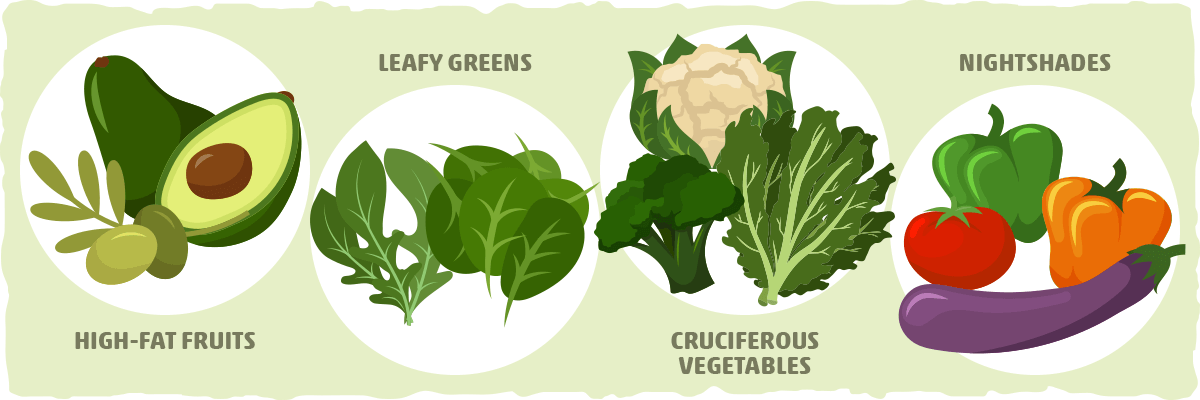
Keto-friendly plant foods will be your secret weapon. Not only are they packed with health-promoting nutrients, but they will make your keto transition as smooth as possible.
For this reason, we recommended incorporating at least a handful of low-carb veggies or high-fat fruits into each keto meal.
A list of the best low-carb vegetables and fruit for keto:
- High-fat fruits — Olives and avocado
- Leafy greens — Spinach, arugula, salad greens, etc.
- Cruciferous vegetables — Broccoli, kale, cauliflower, cabbage, brussels sprouts, etc.
- Nightshades — Tomato, eggplant, bell peppers, etc.
Don’t forget to add more flavor and nutrition to meals with a small amount of alliums (onion, garlic, chives, etc.), mushrooms, and herbs.
For a complete list of keto-friendly vegetables and recipe ideas, check out our guide to keto vegetables.
Keto Food Pyramid Level 4: The Best Keto Dairy
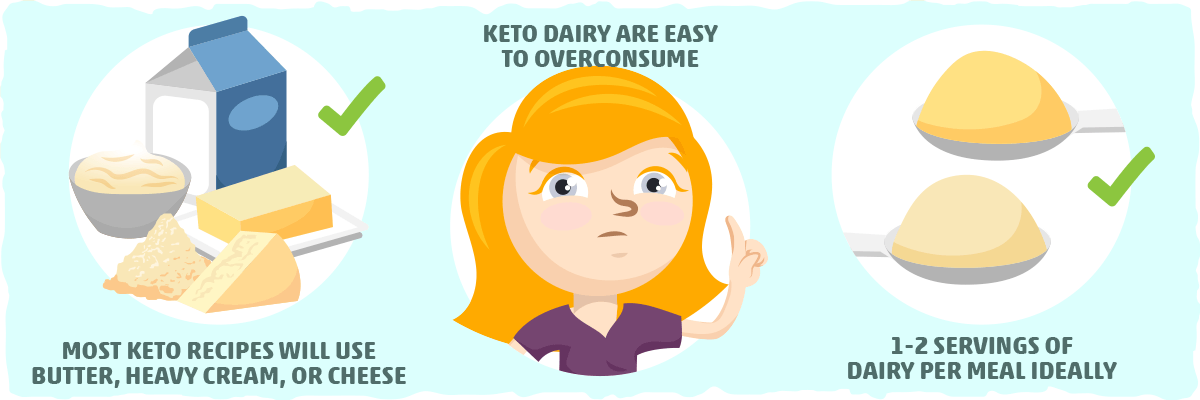
Most keto recipes will call for at least one of these three dairy products:
- Grass-fed butter (or ghee/clarified butter)
- Heavy cream (or heavy whipping cream)
- Cheese
Why? For two main reasons:
- They add flavors and textures that increase how satisfying a meal is.
- They tend to be very low in carbs and high in fat.
However, there’s a catch: Keto dairy products are easy to overconsume.
In fact, one of the most common culprits of keto weight loss plateaus is adding too much cheese and butter to meals.
This is why we recommend keeping your intake of keto dairy within 1-2 servings per meal or less. (That being said, you don’t have to eat dairy to get results with the keto diet. Read our dairy-free keto guide if you’d like to find out how.)
Another crucial consideration with dairy products is to read the serving sizes, nutrition info, and ingredients carefully. When you first start keto, you may find them to add much more fat and carbs than you’d expect.
For a comprehensive list of cheeses and other dairy products that are good for keto, check out our guide to the best and worst low-carb dairy options.
Level 5 of the Keto Food Pyramid: Low Carb Nuts and Seeds
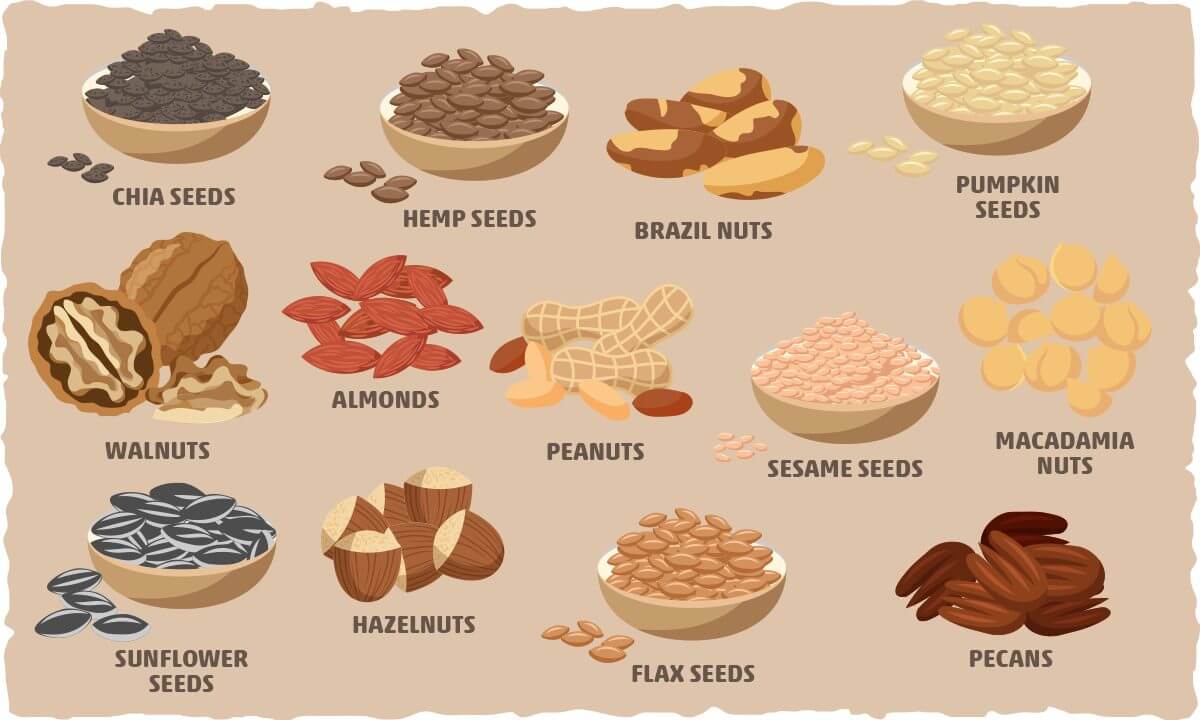
As with keto dairy products, nuts and seeds tend to have a deceivingly high amount of fat and carbs per serving.
For best results, consume only one palmful per day of low-carb nuts and seeds as a high-fat snack or as an addition to keto meals.
The best nuts for keto are:
- Pecans
- Brazil nuts
- Macadamia nuts
- Walnuts
- Hazelnuts
- Peanuts
- Almonds
And keto-friendly seeds include:
- Flax
- Hemp
- Chia
- Sunflower
- Sesame
- Pumpkin
For specific guidelines, recipes, and nutrition info, check out our complete guide to keto nuts and seeds.
The Top of the Pyramid: Nature’s Keto Candy
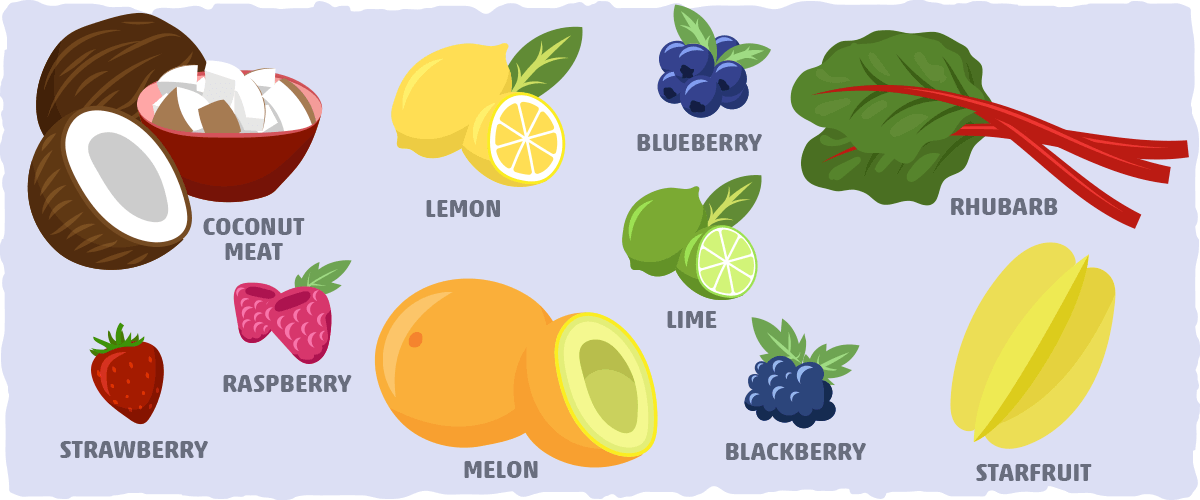
To cap off our keto food pyramid, we feature low-carb fruits (that are also low in fat).
Though these aren’t necessary for a successful keto diet, they are often used to add flavors and health benefits that you can’t get from other low-carb foods.
That being said, it is crucial to keep your servings sizes in mind because their net carbs can add up quickly.
The best low-carb, low-fat fruits for keto include:
- Starfruit
- Blackberry
- Raspberry
- Strawberry
- Rhubarb
- Blueberry
- Coconut meat
- Lemon
- Lime
- Melon
You can typically fit a palmful or less of these fruits into your keto diet daily. However, I highly recommend reading through our guide to low-carb fruit before adding them in.
How to Upgrade the Fat and/or Flavor of Your Keto Meal
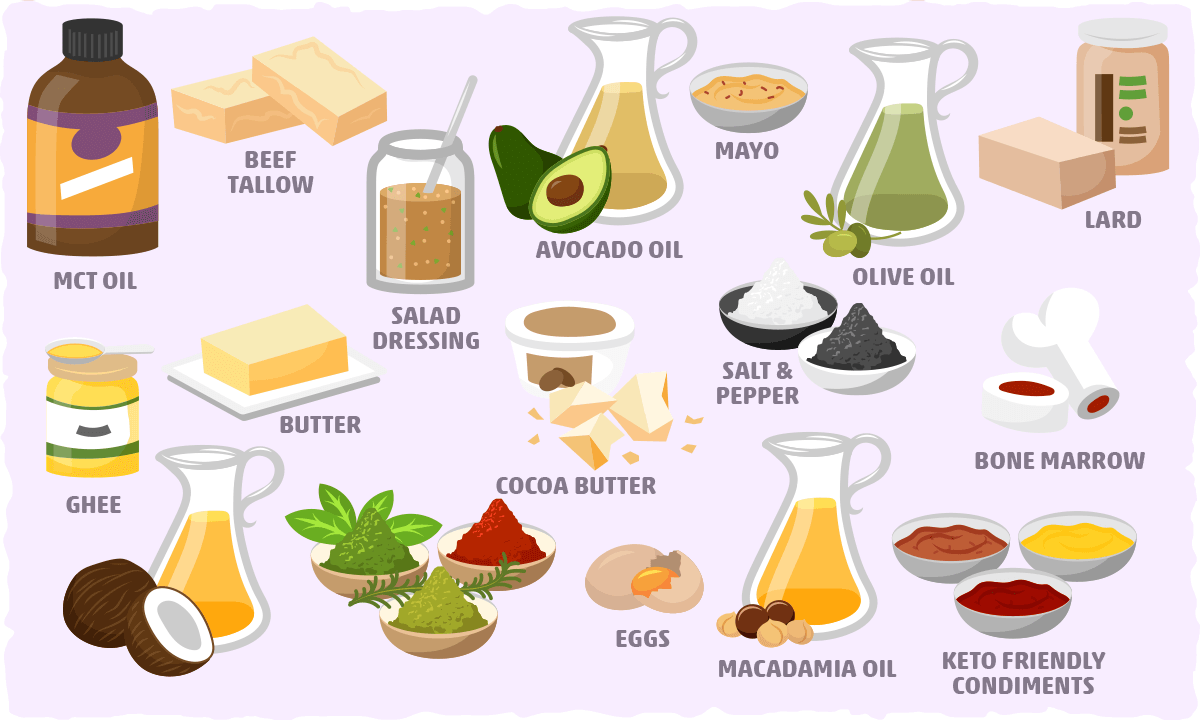
As you’re crafting your keto plate, you may notice that it’s either too low in fat or lacking some flavor. The easiest fix for this is to dress your meal up with high-quality fats/oils and keto-friendly flavor enhancers.
To upgrade the fat content of your meals, try adding 1-2 tbsp of high-quality fats/oils:
- Grass-fed butter or Ghee
- Tallow
- Lard or leftover bacon grease
- Extra virgin olive oil
- Coconut oil
- Avocado oil
- MCT oil (one of the few oils that boosts ketosis directly)
- Bone marrow
- Egg yolk
- Sugar-free Mayo
- Macadamia Oil
- Cocoa butter
- Keto salad dressing
Need fat and flavor? Try these keto options:
- Butter
- Bone marrow
- Egg yolk
- Sugar-free Mayo
- Bacon grease
- Keto salad dressing
If the fat content of your meal is high enough but it still lacks flavor, try these low-calorie flavor enhancers:
- Herbs
- Spices
- Salt
- Pepper
- Keto-friendly condiments — Sugar-free bbq sauce, keto ketchup, marinara sauce, hot sauce, mustard, etc.
What Can You Drink on Keto?
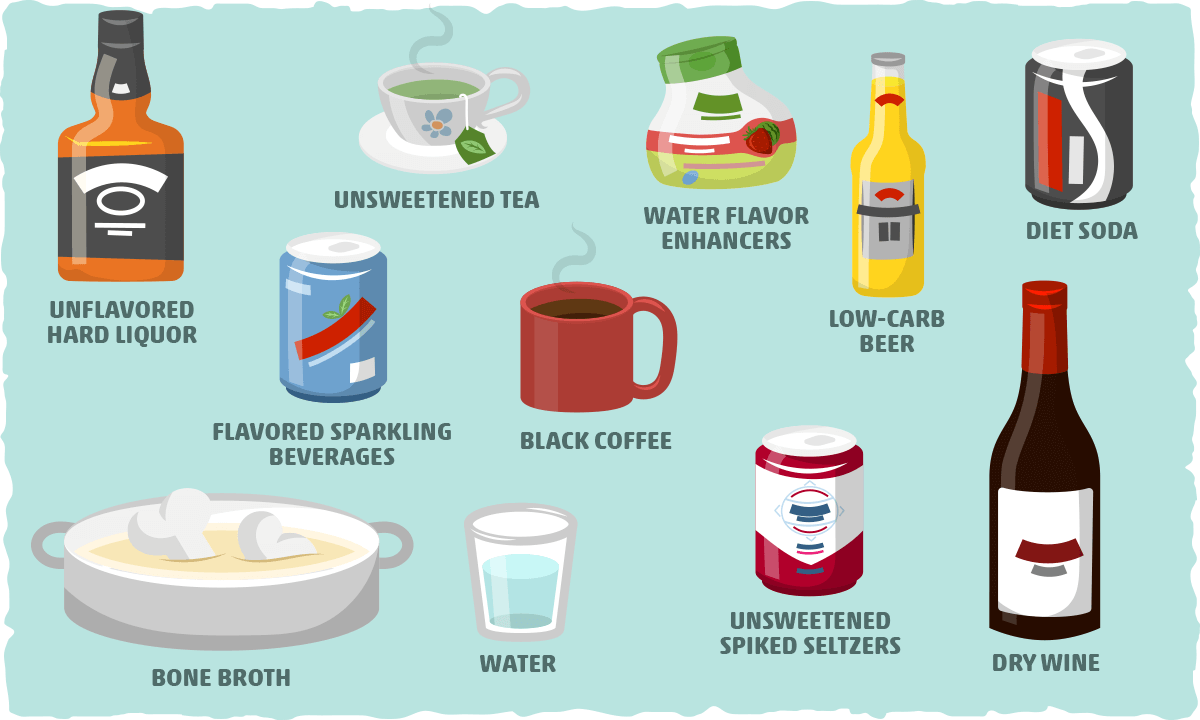
Staying hydrated on keto is crucial, especially as your body sheds excess water weight during your first week of carb restriction. Your go-to options will be water (still or sparkling), black coffee*, unsweetened tea*, and bone broth.
If you want something with more flavor to it, stick with zero-carb options, such as diet soda, flavored sparkling beverages, and water flavor enhancers.
When choosing a flavored drink, however, pay close attention to ingredients and the nutrition label. Opt for zero-carb choices that feature natural sugar-free sweeteners.
Regarding alcohol, the lowest carb alcoholic drinks will be dry wine, low-carb beer, unsweetened spiked seltzers, and unflavored hard liquor. Despite being low in carbs, these should only be consumed in moderation because alcohol consumption impairs our ability to lose fat.
For a complete list of keto-friendly drinks and what to avoid, check out our comprehensive guide to what you can drink on keto.
*Caffeine caveat: As long as you consume less than 500 mg of caffeine (or roughly 5 cups of black coffee) per day, the caffeine will not have a dehydrating effect.
Foods and Drinks to Avoid on Keto
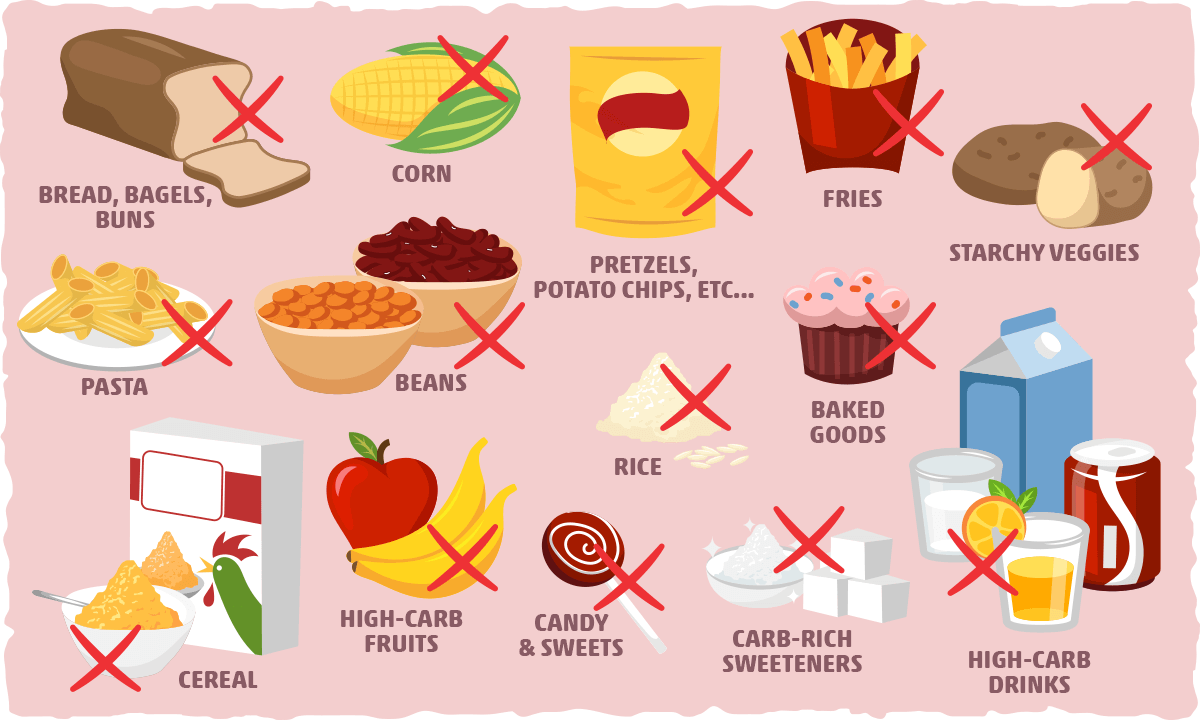
Think back to the base of the USDA food pyramid. There, you’ll find what is known as the bread, cereal, rice, and pasta group.
Ironically enough, these are the exact foods you should avoid on keto and low-carb diets. (Even just one serving of this food group can kick us out of ketosis.)
Other foods to look out for include high-carb fruits, starchy veggies, products with added sugar, sweets, pastries, and baked goods.
To give you a better idea of what to avoid on keto, here is a list of the most common high-carb culprits:
- Bread, bagels, and buns
- Cereal
- Corn
- Pasta
- Beans
- Rice
- Pizza
- Fries
- Pretzels, potato chips, tortilla chips, and other popular snack foods
- Candy and sweets
- Dried fruit
- All carb-rich sweeteners — sugar, brown sugar, honey, agave, maple syrup, etc.
- Baked goods — cookies, cakes, pastries, etc.
- Starchy veggies — potatoes, yams, etc.
- Higher carb fruits — apples, bananas, peaches, pears, etc.
- High-carb drinks — regular soda, fruit juice, most regular beers, milk, etc.
What About <Insert Food Here>? How to Find Out If a Food is Good or Bad for Keto
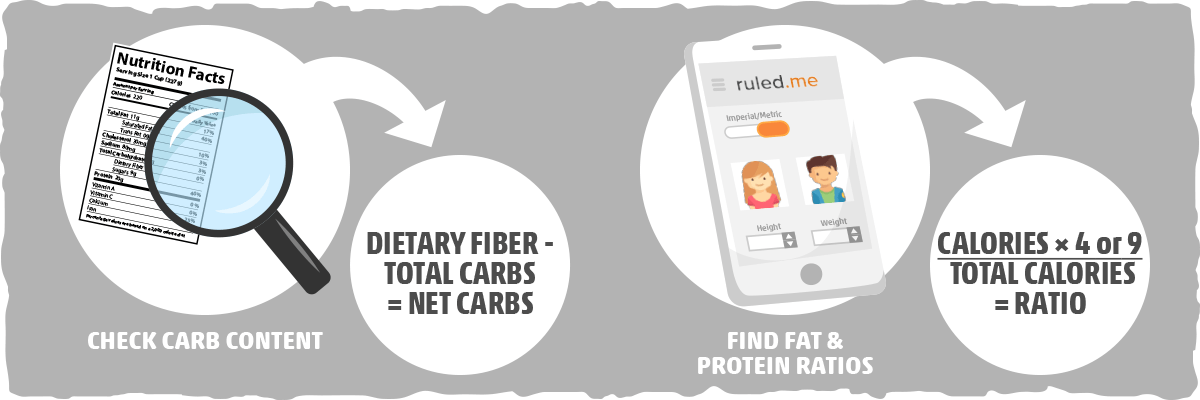
Since it’s nearly impossible to find and categorize every food into its respective keto food pyramid group, we’ve included a quick process you can use to see if a particular item is good or bad for keto:
Step 1: Check the carb content.
Look at the nutrition facts label or search for the information online. The best indicator of how much a food will impact ketosis is its net carb content.
You can find the net carbs in each serving by subtracting total dietary fiber from total carbs (click here for an example calculation).
Is it possible to fit that food within your daily net carb limit (which is typically 25 grams)?
As a general rule of thumb, any food with 10 or more grams of net carbs per serving will be difficult to fit into a keto diet. (In other words: If the net carbs are in the double digits, it’s usually bad for ketosis.)
Step 2: Consider the fat and protein content.
After you’ve found a food that is low enough in carbs, let’s figure out its fat and protein ratio:
- Find the nutrition info on the food label or search for it online.
- Find how many calories from fat are in each serving (or calculate it yourself by multiplying the grams of total fat by 9).
- Divide that number by the total calories per serving.
- Multiply that number by 100, and you’ll get the percentage of fat in that specific food.
For example, let’s take a closer look at bacon:
- According to the USDA, one slice of cooked bacon has 3.3 g of total fat.
- 3 x 9 = 29.7 calories from fat
- 7 calories from fat divided by 43 total calories in a slice = 0.69
- 69 x 100 = 69% fat
- Since keto requires around 70% calories from fat per day, bacon is a great fit for keto.
Note: If you’d like to find the specific protein percentage as well, multiply the grams of protein by 4 (not 9). This will give you the calories of protein per serving, which you can then divide by the total calories per serving and multiply by 100 to get the percentage of protein.
For a more in-depth look at how to find out what foods are keto-friendly for you, check out our comprehensive guide to the best and worst foods for keto.
Practical Takeaways: A Quick Overview of How to Use a Whole Foods Based Keto Pyramid
In general, here is what each day of keto eating will look like according to the keto food pyramid:
Each meal will contain:
- 1-2 palm-sized portions of a fatty cut of meat, seafood, or eggs (>50% fat).
- Are no fatty cuts available? Have leaner cuts of meat/seafood (<40% fat) instead**.
- 1-2 handfuls of low-carb veggies and/or high-fat fruit.
- 1-2 servings of high-fat, low-carb dairy.
**Need to add more fat to your day?
- Try 1 serving of nuts/seeds, or
- Add 1-2 tablespoons of high-quality keto fats/oils to meals, or
- Dress your low-carb meals with 1-2 tablespoons of a high-fat keto condiment (e.g., mayo or sugar-free salad dressing)
Add flavor with:
- Low-carb, low-fat fruits like lemon, limes, or berries
- Onions, garlic, chives, and other allium veggies
- Herbs and spices
- Salt and pepper
Remember to hydrate with these keto staples:
- Water
- Sparkling water
- black coffee (consume less than 5 cups or 500mg of caffeine per day to avoid the dehydrating effect of caffeine)
- unsweetened tea
- bone broth
Avoid these high-carb culprits:
- Grains and grain-based flours
- Baked goods
- Candy and sweets
- Legumes
- Added sugars and high-carb sweeteners
- High-sugar fruits
- Starchy vegetables
- Sugary drinks
How to Optimize Keto for Your Specific Needs, Goals, and Preferences
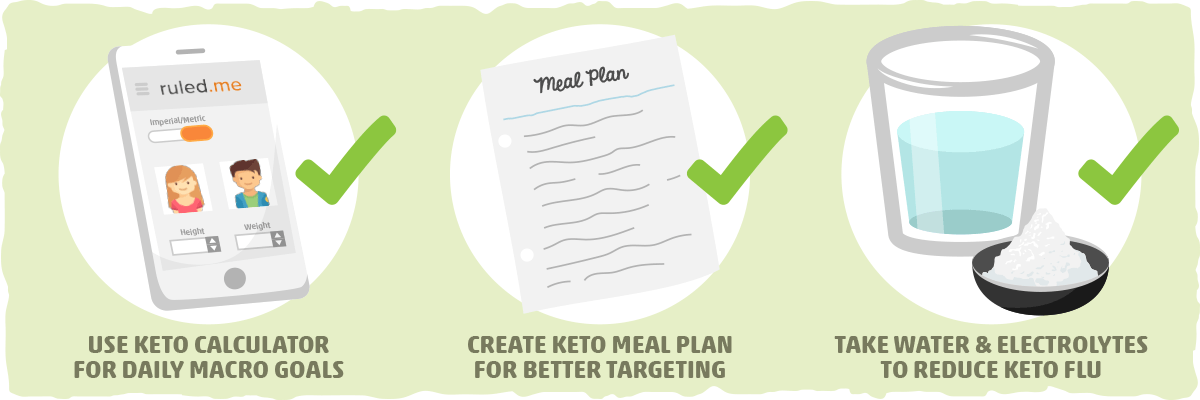
The keto food pyramid is meant to give you a general guideline of what to eat, how much to eat, and what to avoid for better health, weight loss, and ketosis. For many first-time keto dieters, this will be all that’s needed to get started and achieve results.
Though this is possible for you as well, we must also consider what to do if things don’t go as planned. For the most part, these are the three most common keto speed bumps you might run into:
- Experiencing an unintended weight loss plateau for 4 weeks or longer.
- Noticing consistent fat gain over a span of 3-4 weeks.
- Declining health and wellbeing after the first two weeks of keto.
If any of these occur, the first step is to take a closer look at your keto eating and fine-tune your food choices and portion sizes.
In other words, it’s time to tailor your diet to your specific needs, goals, and preferences. To do this yourself, follow this three-step process:
- Use our keto calculator to find your daily keto macro goals.
- Create a meal plan based on the keto food pyramid and keto recipes to develop a better idea of how much you should eat at each meal.
- Replenish the water and electrolytes you lose during the first week of carb restriction. For specific intake guidelines, read through our guide on how to remedy the keto flu.
To dive deeper into each step, read through our guide on how to start keto. There, you’ll find the information you need to fine-tune your diet and create a healthy keto lifestyle.
Putting It All Together: Using the Keto Food Pyramid to Achieve the Results You Want
If you were to simplify everything from this article, you’d end up with the following three steps to getting started and creating your own keto lifestyle:
- Determine how much you need to eat to promote ketosis and achieve expected results.
- Choose whole foods from the keto food pyramid to help you meet those macro goals.
- Monitor your health, wellbeing, and results along the way.
Though implementing these steps will be time-consuming at first, they will set the foundation for a healthy keto lifestyle that helps you to get the results you want and maintain them for life.
In fact, this step-by-step approach to keto is what we used to create our new keto meal planning app. If you’re looking for the easiest solution for your keto goals, this app will do all the calculations and planning for you so that you can get started right away.
Sources
- Dirty, Lazy Keto Vs. Clean Keto Diet [Which Is Right For You] — Ruled.me
- The Ruled.me Food Policy — Ruled.me
- Does Coffee Dehydrate You? — Healthline
- Ketogenic Diet Food List — Ruled.me
- The Keto Oil Guide: The Best, Worst, and What to Avoid — Ruled.me
The post The Keto Food Pyramid: Low Carb Food List Made Simple appeared first on Ruled Me.
https://ift.tt/3stJ3iF
via Ruled Me https://www.ruled.me
April 19, 2021 at 12:34PM
0 Comments